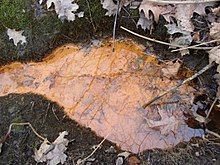
Back بكتريا مؤكسدة للحديد Arabic Eisenoxidierende Mikroorganismen German Bacteria del hierro Spanish Rauabakterid Estonian باکتریهای اکسیدکننده آهن Persian Rautabakteerit Finnish Bactéries oxydant le fer French Vasbaktériumok Hungarian Ferrobatteri Italian 鉄バクテリア Japanese

Iron-oxidizing bacteria (or iron bacteria) are chemotrophic bacteria that derive energy by oxidizing dissolved iron. They are known to grow and proliferate in waters containing iron concentrations as low as 0.1 mg/L. However, at least 0.3 ppm of dissolved oxygen is needed to carry out the oxidation.[1]
When de-oxygenated water reaches a source of oxygen, iron bacteria convert dissolved iron into an insoluble reddish-brown gelatinous slime that discolors stream beds and can stain plumbing fixtures, clothing, or utensils washed with the water carrying it.[2]
Organic material dissolved in water is often the underlying cause of an iron-oxidizing bacteria population. Groundwater may be naturally de-oxygenated by decaying vegetation in swamps. Useful mineral deposits of bog iron ore have formed where groundwater has historically emerged and been exposed to atmospheric oxygen.[3] Anthropogenic hazards like landfill leachate, septic drain fields, or leakage of light petroleum fuels like gasoline are other possible sources of organic materials allowing soil microbes to de-oxygenate groundwater.[4]
A similar reaction may form black deposits of manganese dioxide from dissolved manganese but is less common because of the relative abundance of iron (5.4%) in comparison to manganese (0.1%) in average soils.[5] The sulfurous smell of rot or decay sometimes associated with iron-oxidizing bacteria results from the enzymatic conversion of soil sulfates to volatile hydrogen sulfide as an alternative source of oxygen in anaerobic water.[6]
Iron is a very important chemical element required by living organisms to carry out numerous metabolic reactions such as the formation of proteins involved in biochemical reactions. Examples of these proteins include iron–sulfur proteins, hemoglobin, and coordination complexes. Iron has a widespread distribution globally and is considered one of the most abundant elements in the Earth's crust, soil, and sediments. Iron is a trace element in marine environments.[7] Its role as the electron donor of some chemolithotrophs is probably very ancient.[8]
- ^ Andrews, Simon; Norton, Ian; Salunkhe, Arvindkumar S.; Goodluck, Helen; Aly, Wafaa S.M.; Mourad-Agha, Hanna; Cornelis, Pierre (2013). "Control of Iron Metabolism in Bacteria". In Banci (ed.). Metallomics and the Cell. Metal Ions in Life Sciences. Vol. 12. Springer. pp. 203–39. doi:10.1007/978-94-007-5561-1_7. ISBN 978-94-007-5560-4. PMID 23595674. electronic-book ISBN 978-94-007-5561-1 ISSN 1559-0836 electronic-ISSN 1868-0402
- ^ Alth, Max; Alth, Charlotte (1984). Constructing and Maintaining Your Well & Septic System. Blue Ridge Summit, Pennsylvania: Tab Books. p. 20. ISBN 0-8306-0654-8.
- ^ Krauskopf, Konrad B. "Introduction to Geochemistry" McGraw-Hill (1979) ISBN 0-07-035447-2 p.213
- ^ Sawyer, Clair N., and McCarty, Perry L. "Chemistry for Sanitary Engineers" McGraw-Hill (1967) ISBN 0-07-054970-2 pp.446-447
- ^ Krauskopf, Konrad B. "Introduction to Geochemistry" McGraw-Hill (1979) ISBN 0-07-035447-2 p.544
- ^ Sawyer, Clair N., and McCarty, Perry L. "Chemistry for Sanitary Engineers" McGraw-Hill (1967) ISBN 0-07-054970-2 p.459
- ^ Cite error: The named reference
Madiganwas invoked but never defined (see the help page). - ^ Bruslind, Linda (2019-08-01). "Chemolithotrophy & Nitrogen Metabolism".
{{cite journal}}: Cite journal requires|journal=(help)
© MMXXIII Rich X Search. We shall prevail. All rights reserved. Rich X Search